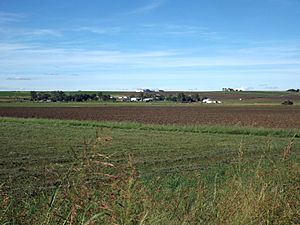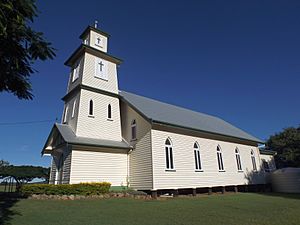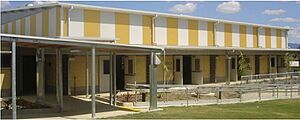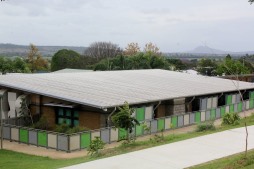Kalbar, Queensland facts for kids
Quick facts for kids KalbarQueensland |
|||||||||||||||
|---|---|---|---|---|---|---|---|---|---|---|---|---|---|---|---|
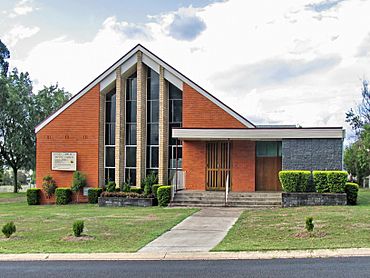
Kalbar Community Baptist Church
|
|||||||||||||||
| Population | 1,246 (2021 census) | ||||||||||||||
| • Density | 39.31/km2 (101.8/sq mi) | ||||||||||||||
| Established | 1876 | ||||||||||||||
| Postcode(s) | 4309 | ||||||||||||||
| Area | 31.7 km2 (12.2 sq mi) | ||||||||||||||
| Time zone | AEST (UTC+10:00) | ||||||||||||||
| Location |
|
||||||||||||||
| LGA(s) | Scenic Rim Region | ||||||||||||||
| State electorate(s) | Scenic Rim | ||||||||||||||
| Federal Division(s) | Wright | ||||||||||||||
|
|||||||||||||||
Kalbar is a small town and area in the Scenic Rim Region of Queensland, Australia. It was once known as Fassifern Scrub and then Engelsburg. In 1916, during World War I, its name was changed to Kalbar. This happened because of strong feelings against Germany at the time.
In 2021, about 1,246 people lived in Kalbar.
Contents
Exploring Kalbar's Location
Kalbar is located in a beautiful area called the Scenic Rim in South East Queensland. It is about 81.8 kilometers (about 50 miles) south-west of Brisbane.
The town is close to the Cunningham Highway. It sits just north of Mount French in the Fassifern Valley. This area is known for its lovely landscapes and farming.
Kalbar's Past: A Journey Through Time
Kalbar has a rich history, especially with German settlers. The town was first called Fassifern Scrub. Later, it was named Engelsburg after an early shop owner, August Engels. Many German families settled here, and you can still see their influence in street names and family names today.
School Days: Kalbar State School
The first school, Fassifern Scrub Provisional School, opened in 1879. It was soon renamed Engelsburg State School. The school moved a few times before settling at its current location on George Street.
In 2007, something unusual happened: a group of microbats moved into the school buildings! These bats are a protected species, but they caused a health risk. So, the affected buildings were taken down. A special "bat haven" was built on the school grounds to give the bats a new home. New bat-proof buildings were opened in 2010.
Over the years, Kalbar State School welcomed students from many smaller schools that closed down nearby.
Post Office and Railways
The Engelsburg Post Office opened in 1897. Like the town, it was renamed Kalbar Post Office in 1916.
A railway line reached Kalbar in 1916, with a station called Kalbar railway station. Another station, Warumkarie, was added later. However, the railway line closed in 1960.
Town Name Change
The name of the town changed from Engelsburg to Kalbar in 1916. This was because of strong anti-German feelings during World War I. At first, only the railway station changed its name. The local School of Arts building changed its name to Kalbar School of Arts in 1918.
Fire and Festivals
In 1920, a big fire destroyed the Kalbar School of Arts hall and many businesses in the town.
From 1961 to 1990, Kalbar held a popular event called the Fassifern Potato Festival. It was a big celebration with a street parade and fun activities. You can find some items from this festival at the Templin Historical Village.
Who Lives in Kalbar?
In 2021, Kalbar had a population of 1,246 people. Most people in Kalbar speak English at home. The most common backgrounds for people living here are Australian, English, and German.
Historic Places in Kalbar
Kalbar has several buildings and places that are important to its history. These are called heritage-listed sites. Some of them include:
- Wiss House, located at 7 Ann Street.
- Fassifern Homestead, found on Boonah-Fassifern Road.
- The School of Arts and Memorial Hall on Edward Street.
- Wiss Brothers Store, located at 101 George Street.
- St John’s Lutheran Church on Teviotville Road.
Learning in Kalbar
Kalbar State School is a primary school for students from Prep (the first year of school) to Year 6. It's located on George Street. In 2022, the school had 252 students.
There isn't a high school in Kalbar itself. Students usually go to Boonah State High School in Boonah, which is nearby.
Community Life and Services
The Scenic Rim Regional Council offers a mobile library service that visits George Street. This means you can borrow books and other materials right in town!
There are also churches in Kalbar, including the Fassifern Christian Church and The Salvation Army - Fassifern Corps.
Fun Events in Kalbar
Kalbar hosts several exciting events throughout the year:
- Annual Agricultural Show: This show is held every June and celebrates farming and local life.
- Kalbar Country Day: This festival takes place in late October each year since 1991. It's a day of fun and community spirit.
- Light Up Kalbar: In early December, the community comes together for this street festival to light up the town's Christmas tree and celebrate the holiday season.
Famous Connections
- John Bradfield, a famous engineer who designed the Sydney Harbour Bridge, started his schooling in Engelsburg (now Kalbar).



